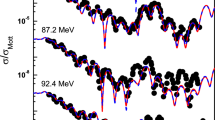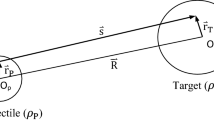Abstract
The 16O + 28Si reaction has been widely studied both experimentally and theoretically and has been claimed to show indications of chaotic scattering. In order to examine this claim and to address whether reaction models such as the optical one could explain the experimental data, we have analyzed the 16O + 28Si system within the framework of the optical model for ten energies from 29.0 to 45.0 MeV, by using microscopic folded potentials, which are based on M3Y nucleon-nucleon, alpha-alpha effective interactions and a phenomenological shallow potential. All potentials describe the individual angular distributions very well at forward angles. However, they fail to describe the individual angular distributions over the whole angular range up to 180°. Nevertheless, we have been able to explain the experimental data by modifying the surface region of the microscopic real potentials by adding two surface potentials. With these correction potentials, we have obtained very good agreement for the individual angular distributions over the whole angular range for the given energies as well as for the experimental data near the Coulomb barrier. The failure of these optical potentials in explaining the scattering observables of this reaction without corrections puts a question mark on the model and supports the idea of a chaotic behavior.
Similar content being viewed by others
References
G. V. Marti et al., Phys. Lett. B 447, 41 (1999).
P. Braun-Munzinger, G. M. Berkowitz, M. Gai, et al., Phys. Rev. C 24, 1010 (1981).
J. Y. Park, W. Greiner, and W. Scheid, Phys. Rev. C 16, 2276 (1977).
J. Y. Park, W. Scheid, and W. Greiner, Phys. Rev. C 10, 967 (1974).
P. Braun-Munzinger and J. Barrette, Phys. Rep. 87, 209 (1982).
W. Sciani, A. Lepine-Szily, F. R. Lichtenthaeler, et al., Nucl. Phys. A 620, 91 (1997).
J. Barrette, M. J. LeVine, P. Braun-Munzinger, et al., Phys. Rev. Lett. 40, 445 (1978).
S. Kahana, B. T. Kim, and M. Mermaz, Phys. Rev. C 20, 2124 (1979).
D. Dehnhard, V. Shkolnik, and M. A. Franey, Phys. Rev. Lett. 40, 1549 (1978).
S. Kubono, P. D. Bond, and C. E. Thorn, Phys. Lett. B 81, 140 (1979).
C. H. Dasso, G. Pollarolo, and M. Saraceno, Nucl. Phys. A 602, 77 (1996); C. H. Dasso, M. Gallardo, and M. Saraceno, Nucl. Phys. A 549, 265 (1992).
G. R. Satchler, Nucl. Phys. A 409, 3c (1983).
M. El-Azab Farid and M. A. Hassanain, Nucl. Phys. A 678, 39 (2000).
RIPL-2, Nuclear Matter Densities, IAEA, http://www-nds.iaea.org/RIPL-2/
A. M. Kobos and G. R. Satchler, Nucl. Phys. A 427, 589 (1984).
M. El-Azab Farid, Z. M. M. Mahmoud, and G. S. Hassan, Nucl. Phys. A 691, 671 (2001).
G. R. Satchler and W. G. Love, Phys. Rep. 55, 183 (1979).
V. G. Neudatchin, V. I. Kukulin, V. L. Korotkikh, and V. P. Korennoy, Phys. Lett. B 34, 581 (1971).
B. Buck, H. Friedrich, and C. Wheathly, Nucl. Phys. A 275, 246 (1977).
L. Marquez, Phys. Rev. C 28, 2525 (1983).
P. Darriulat, G. Igo, H. G. Pughm and H. D. Holmgren, Phys. Rev. 137, B315 (1965).
G. Spitz, H. Klar and E. W. Schmid, Z. Phys. A 322, 49 (1985).
J. Cook, Comput. Phys. Commun. 25, 125 (1982).
I. J. Thompson, FRESCO, a Coupled-Channels Code (unpublished).
I. Boztosun, O. Bayrak, and Y. Dagdemir, Int. J. Mod. Phys. E 14, 663 (2005).
I. Boztosun, Phys. Rev. C 66, 024610 (2002).
A. M. Kobos, G. R. Satchler, and R. S. Mackintosh, Nucl. Phys. A 395, 248 (1983).
S. Y. Lee, Nucl. Phys. A 311, 518 (1978).
D. M. Brink and N. Takigawa, Nucl. Phys. A 279, 159 (1977).
I. Boztosun and W. D. M. Rae, Phys. Rev. C 64, 054607 (2001).
Author information
Authors and Affiliations
Additional information
The text was submitted by the authors in English.
Rights and permissions
About this article
Cite this article
Kocak, G., Karakoc, M. & Boztosun, I. Examination of the 16O + 28Si system with microscopic and phenomenological potentials. Phys. Atom. Nuclei 70, 290–299 (2007). https://doi.org/10.1134/S106377880702010X
Received:
Issue Date:
DOI: https://doi.org/10.1134/S106377880702010X




